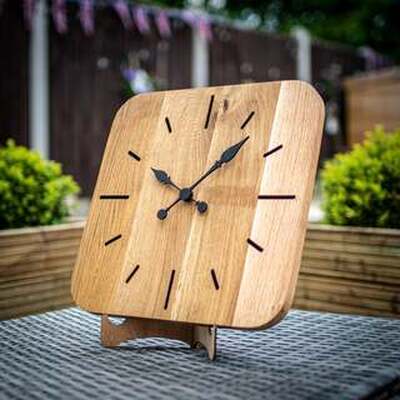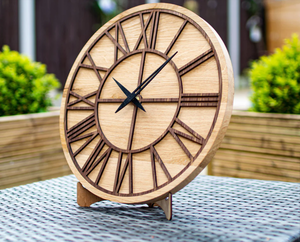The Timeless Beauty of Antique Clocks: A Journey Through History
Body
In today's fast-paced world, where we rely on smartphones and digital devices to keep track of time, there is something enchanting about the ticking and chiming of antique clocks. These timepieces are not just functional; they are intricate works of art that have stood the test of time. In this blog post, we will take you on a journey through the fascinating world of antique clocks, exploring their history, craftsmanship, and enduring appeal.
Chapter 1: The Birth of Antique Clocks
To understand the allure of antique clocks, we must first delve into their origins. The history of timekeeping devices is a tale as old as civilization itself. Early humans used sundials, water clocks, and candle clocks to measure time. However, the concept of mechanical clocks as we know them today began to take shape in the Middle Ages.
1.1 The Mechanical Marvel: The First Clocks The earliest mechanical clocks appeared in Europe during the 14th century. These early timepieces were large, weight-driven machines that were typically found in churches and monasteries. They marked a significant advancement in timekeeping technology and played a crucial role in organizing daily life.
1.2 The Age of Innovation: The 17th Century The 17th century witnessed a surge in clockmaking innovation, particularly in England and the Netherlands. Clockmakers like Christiaan Huygens and Thomas Tompion made groundbreaking contributions to horology, developing pendulum clocks and creating highly accurate timekeeping mechanisms. These innovations laid the foundation for the antique clocks we admire today.
Chapter 2: The Artistry of Antique Clocks
One of the most compelling aspects of antique clocks is their exquisite craftsmanship. Clockmakers from different eras and regions infused their creations with intricate details and artistic flair.
2.1 The Aesthetics of Antique Clocks Antique clocks come in a wide range of styles, reflecting the design sensibilities of their respective time periods. From the opulent Baroque and Rococo styles to the sleek lines of Art Deco, there is an antique clock to suit every taste. Each clock tells a story of the era it hails from, making them both functional timekeepers and pieces of historical art.
2.2 Masterpieces of Miniature Engineering The internal mechanisms of antique clocks are a marvel of engineering precision. Clockmakers meticulously crafted gears, escapements, and balance wheels to ensure accurate timekeeping. Many antique clocks feature stunning visible escapements, allowing enthusiasts to admire the mesmerizing motion of these miniature mechanical wonders.
Chapter 3: The Evolution of Antique Clock Types
Antique clocks come in a variety of forms, each with its own unique charm and purpose. Let's explore some of the most popular types of antique clocks.
3.1 Grandfather Clocks Grandfather clocks, also known as longcase clocks, are iconic timepieces with a tall, freestanding design. They are renowned for their elegant cases, which often feature detailed carvings and ornate decorations. Grandfather clocks have a commanding presence and have been cherished for generations as family heirlooms.
3.2 Mantel Clocks Mantel clocks, as the name suggests, were designed to adorn the mantelpieces of homes. These compact clocks were often decorated with elaborate cases, including intricate woodwork, porcelain, or brass. Mantel clocks were a staple of 19th-century interior design and remain popular collector's items today.
3.3 Bracket Clocks Bracket clocks are small, portable timepieces that were originally designed to be carried or hung on brackets. They were favored by travelers and were often beautifully crafted with brass and intricate dials. Bracket clocks are prized for their portability and aesthetic appeal.
Chapter 4: Collecting Antique Clocks
For enthusiasts and collectors, acquiring and preserving antique clocks is a passion. Collecting antique clocks can be a rewarding journey, but it requires knowledge, patience, and a discerning eye.
4.1 Identifying Authenticity Determining the authenticity of an antique clock is a crucial step in collecting. Examining the clock's movement, dial, case, and any maker's marks can provide valuable clues about its origin and history. Consulting experts or reputable dealers can also help verify the authenticity of a clock.
4.2 Restoration and Maintenance Antique clocks, like any mechanical devices, require regular maintenance to ensure they remain in working condition. Restorations should be carried out by skilled horologists who specialize in antique timepieces to preserve the clock's historical value.
4.3 The Thrill of the Hunt Finding the perfect antique clock for your collection can be an exciting adventure. Antique shops, auctions, and online marketplaces are common places to search for these treasures. However, it's essential to research the market, set a budget, and be patient, as the right clock may not appear immediately.
Chapter 5: Preserving the Legacy of Antique Clocks
The preservation of antique clocks is a responsibility that falls on the shoulders of collectors, museums, and horologists. These timepieces are not just beautiful relics of the past; they are windows into history.
5.1 Museums and Exhibitions Many museums around the world house impressive collections of antique clocks, showcasing their historical and artistic significance. Visiting these museums allows individuals to appreciate the craftsmanship and ingenuity of clockmakers from various eras.
5.2 Conservation Efforts Conservationists work diligently to restore and preserve antique clocks for future generations. They carefully repair and maintain these fragile timepieces, ensuring that they continue to tick for centuries to come.
Conclusion
Antique clocks are more than mere timekeeping devices; they are timeless works of art that bridge the past and the present. Their history, craftsmanship, and enduring appeal make them a captivating subject for collectors and enthusiasts alike. As we continue to embrace modern technology, let us not forget to cherish and preserve these exquisite reminders of our timeless past. Whether displayed in a grand hall, perched on a mantelpiece, or tucked away in a collector's cabinet, antique clocks continue to mark the passage of time in the most elegant and enchanting manner imaginable.











Comments